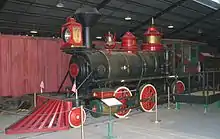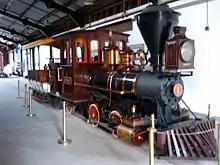Grizzly Flats Railroad
The Grizzly Flats Railroad (GFRR) was a 3-foot (914 mm) narrow-gauge heritage railroad owned by Disney animator Ward Kimball at his home in San Gabriel, California. The railroad had 900 feet (274.3 m) of track, and was operated from 1942 to 2006. It was the first full-size backyard railroad in the United States.
.jpg.webp) The GFRR with Ward Kimball in the foreground | |
| Overview | |
|---|---|
| Headquarters | San Gabriel, California |
| Dates of operation | 1942–2006 |
| Technical | |
| Track gauge | 3 ft (914 mm) |
| Length | 900 feet (274.3 m) |
The GFRR was notable for helping Walt Disney rediscover his childhood fascination with trains, which led him to build the Carolwood Pacific Railroad, a ridable miniature railroad in his backyard. The GFRR also influenced the design of the Disneyland Railroad within the Disneyland theme park in Anaheim, California.
The GFRR's rolling stock, including the two steam locomotives owned by Kimball, are now on display at the Southern California Railway Museum (formerly the Orange Empire Railway Museum) in Perris, California. The railroad's depot building and water tower were moved to the Justi Creek Railway, a private railroad owned by John Lasseter.
History
Grizzly Flats Railroad | |||||||||||||||||||||||||||||||||||||||||||||||||||||||||||||||||||||||||||||||||||||||||||
|---|---|---|---|---|---|---|---|---|---|---|---|---|---|---|---|---|---|---|---|---|---|---|---|---|---|---|---|---|---|---|---|---|---|---|---|---|---|---|---|---|---|---|---|---|---|---|---|---|---|---|---|---|---|---|---|---|---|---|---|---|---|---|---|---|---|---|---|---|---|---|---|---|---|---|---|---|---|---|---|---|---|---|---|---|---|---|---|---|---|---|---|
| |||||||||||||||||||||||||||||||||||||||||||||||||||||||||||||||||||||||||||||||||||||||||||

In 1938, Disney animator Ward Kimball, a lifelong railfan, purchased a passenger coach, built in 1881 by the Barney and Smith Car Company, from the Carson and Colorado Railroad.[1][2] He originally wanted the coach to house his collection of model trains at his home in San Gabriel, California; however, his wife Betty suggested that he should also have a locomotive to pull the coach.[2][3] A suitable locomotive, the Sidney Dillon, was purchased for $400 from the Nevada Central Railroad, which was selling it for scrap.[4] A 2-6-0 steam locomotive built by Baldwin Locomotive Works in 1881, it was renamed Emma Nevada, after the late 1800s opera star Emma Nevada.[3] Over the course of several years, Kimball, his family, and his friends worked to restore the engine to operating condition.[4] The railroad became operational in 1942.[5] Kimball named his railroad Grizzly Flats Railroad (GFRR), which eventually consisted of 900 feet (274.3 m) of 3 ft (914 mm) narrow-gauge track, including a 500-foot (152.4 m) main line.[4][6] The GFRR became the first full-size backyard railroad in the United States.[7]
In the years to follow, Kimball added a boxcar, a cattle car, a gondola, a caboose, and a second locomotive to the GFRR.[8][9] The second locomotive was a 0-4-2T steam locomotive built by Baldwin Locomotive Works in 1907, and was originally run on the Waimanalo Sugar Plantation on the Hawaiian island of Oahu.[1][10] As opposed to the Chloe, which burned wood to generate steam, the Emma Nevada burned coal.[3] Kimball was forced to stop running the Emma Nevada in 1967 due to complaints from his neighbors regarding the coal smoke it created.[9][10][11] The Chloe pulled a set of train cars custom made by Kimball, consisting of a four-bench open car built around 1975 and two passenger-carrying gondolas built around 1993.[6] Kimball gradually added several structures to the GFRR, including a roundhouse, a water tower, a windmill, and a depot building.[1][12] The depot building was given to him by his boss, Walt Disney, and was originally used as a set piece for the 1949 Disney film So Dear to My Heart.[13][14] Kimball died in 2002, but his family continued to operate the GFRR until 2006.[6][9]
Influences and preservation

Kimball shared his railroad hobby with fellow Disney animator Ollie Johnston, who owned a ridable miniature railroad, and Walt Disney.[15][16] On October 20, 1945, Disney attended one of the Kimball's "steam-ups", which were parties hosted at their home when the Grizzly Flats Railroad was in operation.[17] During the party, Disney was given the opportunity to drive the GFRR's Emma Nevada locomotive, which was the first time since working as a teenager on the Missouri Pacific Railway that he had been inside a locomotive cab.[17] Disney eventually decided to have his own backyard railroad built, which he named Carolwood Pacific Railroad.[18] His ridable miniature backyard railroad, and the narrow-gauge GFRR, inspired Disney to create the Disneyland Railroad within the Disneyland theme park in Anaheim, California.[2][19] The Disneyland Railroad's depot building in the Frontierland section of the park was built using the same blueprints for the GFRR's depot building.[13]
In late 1992, Kimball began to donate the GFRR's rolling stock to the Orange Empire Railway Museum in Perris, California.[9][11][17] The last of the rolling stock remaining on the GFRR, including the Chloe locomotive, was put on display at the museum in 2007.[6] The GFRR's depot building and water tower were acquired by former Pixar film director John Lasseter, who moved them to his private Justi Creek Railway.[20][21][22]
References
- Broggie (2014), p. 52.
- Amendola (2015), p. 118.
- Amendola (2015), p. 119.
- Broggie (2014), p. 56.
- Gross, Cory (April 9, 2011). "The Madness of Ward Kimball". Network Awesome. Archived from the original on September 19, 2015. Retrieved August 11, 2017.
- "Grizzly Flats (3-Foot Gauge)". Orange Empire Railway Museum. Archived from the original on March 18, 2017. Retrieved August 12, 2017.
- Broggie (2014), p. 53.
- Amendola (2015), p. 120.
- Pool, Bob (May 12, 2007). "Railroad Hits End of the Line". Los Angeles Times. Archived from the original on March 29, 2019. Retrieved March 29, 2019.
- Kelley, Ed (July 10, 2002). "We Remember Ward Kimball: 1914-2002". Discover Live Steam. Archived from the original on July 13, 2017. Retrieved March 25, 2018.
- Ford, Andrea (November 16, 1992). "End of the Line: Locomotive from Back-Yard Railroad Heads for Museum". Los Angeles Times. Archived from the original on September 19, 2015. Retrieved March 20, 2019.
- Broggie (2014), pp. 54–55.
- Broggie (2014), pp. 266–267.
- Ballard, Kelli (February 16, 2016). "Disneyland Depot Inspired by Porterville". The Porterville Recorder. Archived from the original on April 7, 2019. Retrieved June 12, 2019.
- Broggie (2014), p. 17.
- Broggie (2014), p. 100.
- Broggie (2014), p. 58.
- Broggie (2014), p. 109.
- Amendola (2015), pp. 138–139.
- Amendola (2015), p. 133.
- McFarland, Kevin (June 23, 2015). "Pixar's Best Director Is Also Its Most Underrated". Wired. Archived from the original on December 23, 2016. Retrieved February 8, 2017.
- Maddaus, Gene (June 8, 2018). "John Lasseter Will Exit Disney at the End of the Year". Variety. Archived from the original on January 29, 2019. Retrieved February 2, 2019.
Bibliography
- Amendola, Dana (2015). All Aboard: The Wonderful World of Disney Trains (1st ed.). Disney Editions. ISBN 978-1-4231-1714-8.
- Broggie, Michael (2014). Walt Disney's Railroad Story: The Small-Scale Fascination That Led to a Full-Scale Kingdom (4th ed.). The Donning Company Publishers. ISBN 978-1-57864-914-3.
External links
| Wikimedia Commons has media related to Grizzly Flats Railroad. |
